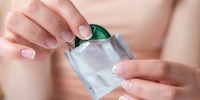
Background information
Good for you, good for the planet – «green sex» products
by Olivia Leimpeters-Leth

Once applied, heat patches are designed to relieve back pain as well as tension in the neck and shoulders. If you ask the experts, however, the products are a bit of a hot potato. Here’s what you need to know about them.
Performing as his sleezy alter ego Horst Sclämmer, German comic Hape Kerkeling made a lot of people crease up with his catchphrase: «I get back pain, sweetheart». But if your own back-related woes are stopping you from laughing along, you’re not the only one. According to a 2020 report issued by Rheumaliga Schweiz (link in German), two thirds of the population suffer from non-specific back pain several times a year.
The good news is that in 80 per cent of cases, the pain is gone within 4-6 weeks at the most. Still, the longer you leave your pain untreated, the greater the risk that it’ll become chronic. In Germany alone, 1 in 4 women and 1 in 6 men are affected by chronic back pain lasting at least three months, according to the Robert Koch Institute. As for Switzerland, the figures are similar.
This makes the condition, alongside headaches, one of the most common pain problems of all. Not only that, but it’s the number one cause of incapacity for work. That alone is a good reason not to ignore your symptoms, and to seek medical advice.
It’s not always an injury, arthritis, osteoporosis, rheumatism or a herniated disc that causes pain. Most of the time, it’s muscle stress or inactivity that leads to muscle tension and non-specific lower back pain. US-American physician Dr James Levine pointed out in a study that people who spend longer than six hours a day sitting down reduce their lifespan by 20 per cent. Consequently, Levine actually claims that sitting is worse for your health than smoking.
This means the best way to avoid back problems (and kicking the bucket before your time) is regular phyiscal activity. As for those who’ve already got a twinge in the neck, shoulders or back, moderate exercise such as walking or Tai chi is the order of the day. «This is because rest only provides short-term relief for non-specific back pain,» says Professor Michael Hüppe, Vice President of the Deutsche Schmerzgesellschaft (German Pain Society). «In the long run, it causes the pain to become entrenched.»
According to Hüppe, anyone who wants to turn their back on a life of pain, so to speak, can of course complement their physio regimen with additional forms of therapy. In addition to pharmaceuticals, the German Medical Association lists as many as 29 non-drug therapies in its scientific guidelines on non-specific lower back pain (link in German). Alongside accupuncture and massage, heat therapy also bagged a mention on the list.
Heat is said to activate the body’s own self-healing powers. When the temperature of the skin and muscles is raised, blood flow is increased, which stimulates the metabolism and the supply of oxygen and nutrients to the tissues. And that’s not the only benefit of using heat therapy: «Heat essentially masks pain, because the body is more sensitive to the thermal stimulus than the pain stimulus,» writes Martina Landolf, CEO of Physiozentrum.ch AG, the largest independent provider of physiotherapy in Switzerland, in a blog post.
This mechanism, also known as gate control theory, was discovered as early as 1965. «And when we feel less pain, we’re able to get moving again and mobilise painful parts of the body better,» she continues.
Before you start treating your pain with heat, you should figure out what’s causing it. Heat is particularly helpful for muscular pain, such as tension in the neck or shoulders. However, it can also help with chronic back or joint pain. When it comes to nerve irritation or (joint) inflammation, however, heat is counterproductive. Nor is heat therapy advisable for acute, very severe pain – after a bone fracture, for example. In cases like these, a natural inflammatory reaction takes place, during which the blood vessels dilate and the temperature of the tissue itself increases. As a result, cold is the best way to go here.
Once your doctor has given heat therapy the green light, it’s important you’re able to feel a noticeable heat for as long as possible. According to the Campaign for Healthier Backs based in Selsingen, Germany, the ideal therapetutic heat is 40° Celsius and lasts 4–12 hours. Traditional home remedies such as taking a bath, spending time in a sauna, using cherry stone pillows or undergoing red light therapy rarely allow this kind of constant temperature to be sustained over a long period of time. That’s why heat patches are so popular. You simply stick them on, and after just a few minutes, you’ll feel a pleasant warmth that retains its temperature while you get on with other things.
In Germany alone, pharmacies, drugstores and even discount supermarkets and DIY stores sell more than four million of them for local pain therapy annually. So the patches are a great little earner for the pharmaceutical industry. In fact, IQVIA’s pharmaceutical market report IMS Health 2016 revealed the products to have generated 82 million euros in turnover.
So do heat patches actually help? That depends, as not all heat patches are made equal. Some products contain natural capsaicin, i.e. cayenne pepper extract, or its synthetic form nonivamide, and most of them are approved for medical use. They’re comparatively cheap, convenient for when you’re on-the-go, and low-risk. Clincial studies have proven that capsaicin temporarily inhibits the reuptake of the neurotransmitter substance P at the nerve endings, which blocks the transmission of pain signals.
The feeling of warmth it creates, however, actually results from irritation of the skin, which can be uncomfortable. It’s best to test the patch on a less sensitive area of your skin first to see if you can tolerate it. You should definitely stop using it if you find the heat too intense or if you experience itching, burning or stinging. Such symptoms could indicate a chilli allergy. If there are any wounds on your skin or if you have a skin condition or infection, you should steer clear of capsaicin patches altogether.
If you have sensitive skin, you can opt for self-heating patches that don’t contain any potential skin irritants. These alternatives generate heat by phyiscal means and emit a deep warmth. These catalytic patches or pads contain a mixture of iron powder, water and sometimes activated carbon, which combines with oxygen once the seal on the packaging is broken.
The downside to these heat pads is that they’re usually more expensive than capsaicin patches. What’s more, during a review conducted by consumer magazine Gesundheitstipp, those testing the pads reported they occasionally wouldn’t hold and that the heat they emitted was only lukewarm. Incidentally, the product that came up trumps during the Swiss expert’s review was the HerbaChaud, a heat patch capable of maintaining its warmth for 24 hours.
Even when using the HerbaChaud, however, those with allergies need to exercise caution. After all, it didn’t fare well in the heat patch review conducted by consumer protection magazine Öko-Test (article in German) – and the same can be said for other catalytic patches. The reason? Some of them contain questionable ingredients, including brighteners in the adhesive. «These brighteners can get onto your skin when you sweat, and in combination with sunlight, trigger allergic reactions,» the experts concluded. The same applies to lanolin, which can cause contact dermatitis.
But it’s not just allergy sufferers who should read the packaging label carefully. Because of the risk of overheating, the instructions usually advise against using heat patches over night.Improper use of products containing iron and activated carbon also poses a burn hazard. «The worst cases, in addition to redness and blisters, even involve necrosis i.e. the death of skin tissue.» Not only that, but if the pad stays in the same place for an extended peiod of time, permanent changes to the skin’s pigmentation (also known as «hot water bottle rash») can occur. To minimise these risks, you can go for patches that can be applied over your clothing, instead of directly onto your skin.
Whether applied to the skin or to clothing, catalytic heat patches are controversial. «There isn’t yet clear proof that they have a pharmacological impact,» concluded researchers from Öko-Test. That means heat patches don’t fall into the category of pharmaceutical products. Instead, they’re approved as «medicinal products with a physical effect». All the more reason to seek expert advice or go for capsaicin patches instead (provided you’re not allergic to them).
Header image: Shutterstock
If my job didn't exist, I'd definitely invent it. Writing allows you to lead several lives in parallel. On one day, I'm in the lab with a scientist; on another, I'm going on a South Pole expedition with a researcher. Every day I discover more of the world, learn new things and meet exciting people. But don't be jealous: the same applies to reading!
Customize Mediahouse cares about the meaning and benefit for the customer: we inspire people with emotional content that's worth consuming and sharing.
Interesting facts about products, behind-the-scenes looks at manufacturers and deep-dives on interesting people.
Show all
Background information
by Olivia Leimpeters-Leth

Background information
by Martin Rupf

Background information
by Mareike Steger